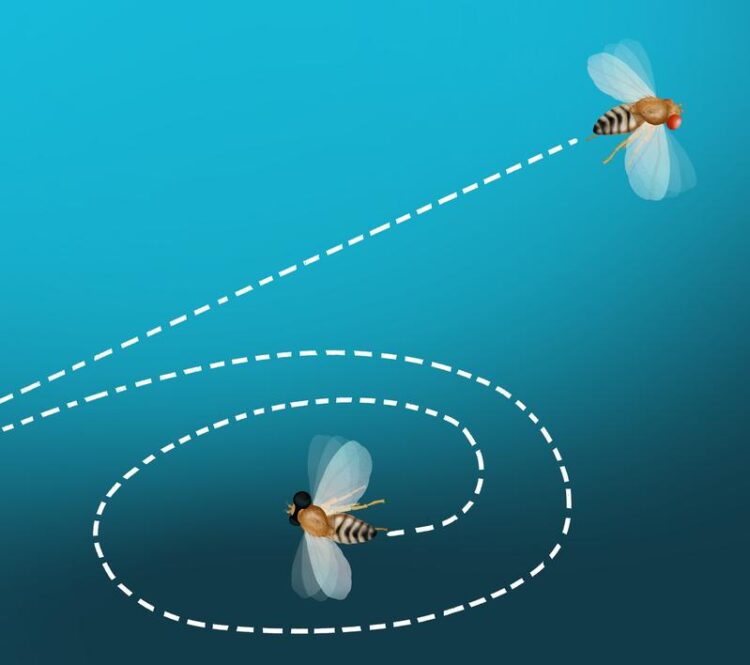The complex task of staying on course

Fruchtfliegen, die keine Bewegungen wahrnehmen können, haben Probleme ihren Kurs im freien Flug zu halten.
© MPI für Neurobiologie / Julia Kuhl
Walking blindfolded in a straight line is a difficult task. Most of the time, we end up running in circles. Fruit flies that are blind to motion have similar problems during free flight: They only manage to fly straight for short distances, as researchers at the Max Planck Institute of Neurobiology have now shown. Motion vision is thus the component of visual perception that contributes decisively to course control in fruit flies.
Walking in straight line towards a tree is not particularly difficult for us. Put on a blindfold, however, and the task becomes nearly impossible. Already about one hundred years ago, the researcher Asa Schaeffer showed that, in this case, we do not walk straight ahead for long. After a short time, we start to drift to one side and walk in circles – usually we never reach the tree.
But why is that? What kind of computations in the brain keep us on track when our eyes are open? There are two possible explanations. Many would assume that as long as a landmark (in this case a tree) is present in our field of view, walking straight is easy: We can adjust our position at all times to keep the landmark in front of us. However, there is an alternative explanation for being able to stay on track which is orientating by the so-called ‘optic flow’. Imagine driving your car down an alley. You will observe that the trees are sweeping from the front to the back on both sides of you. If the road is straight, the flow of trees is balanced between both sides. However, in a curve, this is not the case. Consequently, the flow of objects in your field of view as you are moving can also indicate whether you drive straight or not.
To study the influence of these alternatives on the ability to walk straight, it is crucial to solely remove the visual system component, which is at heart of perceiving optic flow: motion vision. Of course, doing such experiments in humans is impossible. In contrast, fruit flies offer many opportunities to get to the bottom of this question. They are at present the only animals which offer genetic tools to take away motion vision while keeping landmark orientation and other visual functions intact.
Therefore, Maria-Bianca Leonte and her colleagues from Alexander Borst’s department analyzed how fruit flies achieve course control in different circumstances. To recreate conditions as realistic as possible, she observed the flies flying freely in an arena.
Maria-Bianca Leonte first traced the flight trajectories in complete darkness. These experiments revealed that flies, very much like people when blindfolded, can no longer keep a straight course over long distances. Thus, vision is important for flies as well to stay on course. Yet, is landmark orientation or optical flow the deciding visual factor? To answer this question, the researchers turned flies motion-blind. They silenced precisely those neurons in the tiny fly brain that are known to compute the direction of motion. It turned out that motion-blind flies, much like flies in the dark, cannot fly straight for long.
To further test this result, the researchers complicated the conditions by shortening one wing a tiny bit. Normal-sighted flies were able to compensate for these aerodynamic changes without any problems. Flies in the dark and motion-blind flies, however, began to fly in circles.
Maria-Bianca Leonte explains: “Our results show that, in flies, it is motion vision that is the key to course control, not landmark orientation. With our experimental setup, we can now investigate what role other sensory components play in course control, and how they interact with the sense of motion vision”.
CONTACT:
Dr. Christina Bielmeier
Public relations
Max Planck Institute of Neurobiology, Martinsried
E-mail: bielmeier@neuro.mpg.de
Wissenschaftliche Ansprechpartner:
Prof. Dr. Alexander Borst
Department Circuits – Computation – Models
Max Planck Institute of Neurobiology, Martinsried
E-mail: thalhammer@neuro.mpg.de
Originalpublikation:
Maria-Bianca Leonte, Aljoscha Leonhardt, Alexander Borst, Alex S. Mauss
Aerial course stabilization is impaired in motion-blind flies
Journal of Experimental Biology, 23.07.2021
DOI: 10.1242/jeb.242219
Weitere Informationen:
https://www.neuro.mpg.de/borst – Department website
https://www.neuro.mpg.de/news/2021-07-borst – Here you can find an audio version of this press release
Media Contact
All latest news from the category: Life Sciences and Chemistry
Articles and reports from the Life Sciences and chemistry area deal with applied and basic research into modern biology, chemistry and human medicine.
Valuable information can be found on a range of life sciences fields including bacteriology, biochemistry, bionics, bioinformatics, biophysics, biotechnology, genetics, geobotany, human biology, marine biology, microbiology, molecular biology, cellular biology, zoology, bioinorganic chemistry, microchemistry and environmental chemistry.
Newest articles

Innovative 3D printed scaffolds offer new hope for bone healing
Researchers at the Institute for Bioengineering of Catalonia have developed novel 3D printed PLA-CaP scaffolds that promote blood vessel formation, ensuring better healing and regeneration of bone tissue. Bone is…

The surprising role of gut infection in Alzheimer’s disease
ASU- and Banner Alzheimer’s Institute-led study implicates link between a common virus and the disease, which travels from the gut to the brain and may be a target for antiviral…

Molecular gardening: New enzymes discovered for protein modification pruning
How deubiquitinases USP53 and USP54 cleave long polyubiquitin chains and how the former is linked to liver disease in children. Deubiquitinases (DUBs) are enzymes used by cells to trim protein…



